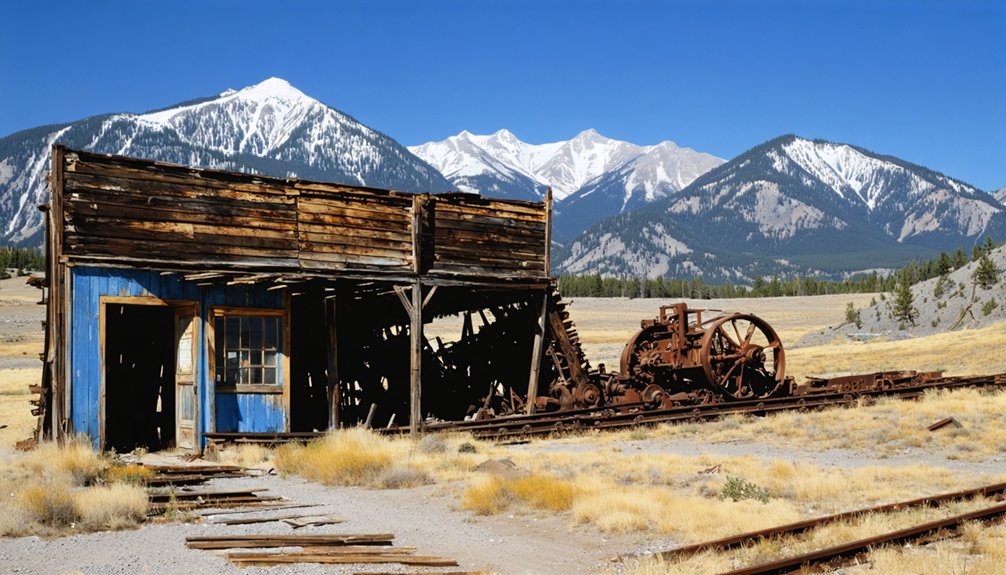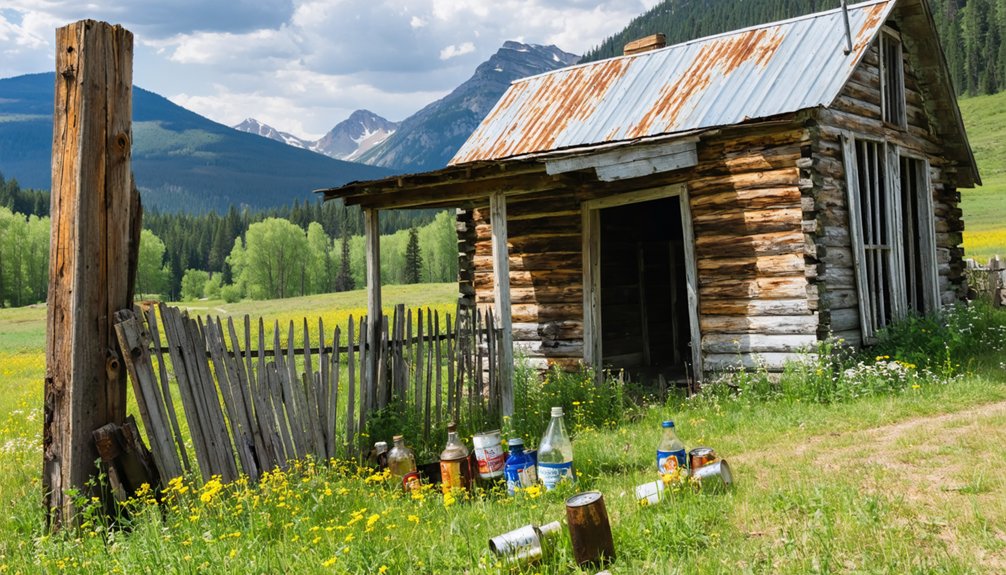You’ll find Concord ghost town deep in Idaho’s rugged mountains, where thousands of miners flocked during the 1860s gold rush. The town flourished briefly as a mining hub, with three prominent saloons and a post office that operated until 1913. Nearly $1 million in gold was extracted before harsh winters, isolation, and declining ore quality forced its abandonment. Today’s ruins and scattered mining artifacts tell a compelling story of frontier ambition and ultimate defeat.
Key Takeaways
- Concord was a mining town that thrived during Idaho’s gold rush era but is now abandoned and reclaimed by wilderness.
- The site requires a high-clearance 4WD vehicle and is inaccessible from November through June due to heavy snowfall.
- No intact buildings remain, but visitors can see remnants of early 20th-century mining operations, abandoned shafts, and scattered artifacts.
- The town once featured three prominent saloons, with Paddy’s Saloon being the most notable gathering spot for miners.
- Extreme geographic isolation and challenging winter conditions ultimately led to Concord’s abandonment and current ghost town status.
The Gold Rush That Started It All
While many gold rushes shaped the American West, Idaho’s defining moment began in 1860 when prospectors struck gold near Pierce at the confluence of Orofino and Canal Creeks.
The initial placer discoveries sparked a mining influx that would transform the territory, with fortune seekers flooding the region’s streams and creeks in search of golden riches. Panic City eventually emerged as one of the most populated areas in the northwest.
Two years later, the Boise Basin discovery would prove to be Idaho’s most significant gold-producing region, eventually yielding nearly 3 million troy ounces of precious metal.
Life in a Booming Mining Town
You’d find daily life in Concord centered around the arduous work of mining gold, silver, and copper from the surrounding Buffalo Hump district’s claims.
Mail delivery proved essential to connecting residents with the outside world, as the town operated its own post office until 1913.
After long days of backbreaking labor, you could join other miners at one of the town’s bustling saloons for refreshments like Nesbitt’s Root Beer or stronger spirits while catching up on local news. In fact, when the town first emerged, it was one of several communities that served thousands of miners during the region’s peak.
During winter months, you’d navigate through snow-carved stairways just to reach building entrances, showing how the harsh mountain conditions shaped even the most basic aspects of the community’s existence.
Daily Mining Operations
During the peak of Concord’s mining operations, a typical day began before sunrise as miners descended into dangerous underground shafts armed with picks, shovels, and dynamite.
Similar to Silver Valley’s industrial backbone, mining crews operated in shifts around the clock to maximize production.
You’d find teams of men performing backbreaking manual labor, working long shifts to extract precious ore from the earth’s depths.
As mining techniques evolved, you could witness both placer and quartz mining operations.
Early prospectors would pan streambeds using rockers and sluice boxes to separate gold from gravel.
Later, hard rock mining required more sophisticated methods – blasting through solid rock and hauling ore to stamp mills for crushing. The extraction of zinc and lead became a major focus as the mining industry matured in the region.
You’d see miners rotating through different roles, from operating equipment to hauling rock, while enduring harsh conditions underground.
The work was demanding and perilous, but the promise of striking it rich kept these determined men going day after day.
Saloon and Social Life
Three prominent saloons anchored social life in Concord, with Paddy’s Saloon standing as the most notable establishment. You’d find these bustling venues near the post office, where they served as much more than just drinking spots. The old post office stood prominently in the center of town, making it a natural gathering point. Today, only the remains of Paddy’s Saloon still stand as a testament to this once-thriving community.
The saloon atmosphere pulsed with card games, impromptu music from upright pianos, and the steady flow of mining news and prospects.
During community gatherings, you’d see miners, merchants, and local families mixing together, creating a temporary escape from the harsh realities of mining life.
Women played crucial roles as proprietors, entertainers, and service workers, though the social structure remained largely male-dominated.
While the rough-and-tumble environment occasionally sparked alcohol-fueled disputes and gambling, these establishments provided essential spaces for networking, dealmaking, and fostering the connections that kept Concord’s social fabric intact.
Geographic Challenges and Isolation
While many ghost towns in Idaho face natural barriers, Concord’s extreme geographic isolation stands as a proof to the challenges that ultimately led to its abandonment.
You’ll find this remote settlement surrounded by wilderness on three sides, with access limited to a brief summer window due to heavy snowfall that blankets the region from November through June.
The logistical challenges of reaching Concord today mirror its historical struggles:
The difficulties we face in accessing Concord echo the very obstacles that sealed its fate as a ghost town.
- You’ll need a high-clearance 4WD vehicle to navigate the unmaintained roads beyond Orogrande.
- You won’t find services, cell coverage, or emergency assistance within 10 miles.
- You’re facing steep grades and dense forest, with the nearest supplies in Elk City.
The journey requires traversing bone-rattling terrain on the Devils Staircase, climbing over 3,000 feet to reach an elevation of 7,600 feet.
The remote location was once home to the Big Buffalo mine, though minimal production was recorded from the area.
This isolation ultimately proved insurmountable for sustained settlement, earning Concord its nickname: “The End of the World.”
The Decline of Mining Operations
You’ll find that Concord’s mining operations faced a devastating economic blow when the Presidential Mine decree of 1907 forced its closure, marking the end of large-scale mineral extraction in the area.
The region’s harsh weather conditions, particularly severe winters and spring flooding, had consistently hampered mining efforts and contributed to operational failures.
Economic pressures from the closure rippled through the community, forcing many residents to abandon their homes and businesses in search of opportunities elsewhere.
Economic Impact of Closure
When mining operations ceased in Concord, the economic impact devastated the region’s workforce and industrial importance. The job displacement rippled through every sector of the local economy, from equipment suppliers to general stores.
You’ll find the economic consequences were particularly severe as Idaho’s mineral production rankings tumbled, and the town’s tax base evaporated.
The closure’s stark reality manifested in three distinct ways:
- Over 80 year-round mining positions vanished from Meadow Creek Mine alone
- Ancillary businesses dependent on mining operations shut down permanently
- The Yellow Pine district’s once-proud antimony and gold production fell to negligible levels
Without viable employment alternatives, families were forced to relocate, transforming Concord into another victim of Idaho’s mining boom-and-bust cycle.
Weather’s Role in Failure
Despite Concord’s rich mineral deposits, the harsh central Idaho climate played a decisive role in the mine’s ultimate downfall.
You’d find mining operations severely restricted by long, brutal winters that blocked access roads for months. Weather patterns created a perfect storm of challenges: seasonal freeze-thaw cycles damaged equipment, while heavy rains triggered dangerous landslides and flooded mine shafts.
The region’s mining viability further suffered from unreliable water supplies. When droughts hit, you couldn’t count on sufficient water for hydraulic mining and ore processing.
These conditions made low-grade ore deposits particularly unattractive to investors. The brutal climate’s constant assault on infrastructure, combined with increased operational costs and transportation disruptions between Elk City and Orogrande, ultimately convinced miners to seek their fortunes elsewhere.
Final Presidential Mine Decree
As late-stage mining operations struggled in Concord, a sweeping Presidential Mine Decree in 2024 paradoxically arrived too late to salvage the town’s mineral industry.
While the decree aimed to revitalize America’s mining sector by slashing regulations and expediting permits, you’ll find Concord’s mines had already succumbed to decades of regulatory burden and economic pressure.
The decree’s impact would’ve transformed Concord’s mining landscape through:
- Complete rescission of federal mining claim restrictions
- Streamlined permitting for mineral exploration on public lands
- Financial support through federal loans and grants for mining operations
You can still see remnants of what might’ve been – abandoned shafts and weathered processing facilities stand as silent witnesses to a town that could’ve flourished under the new presidential decree’s mining-friendly regulations.
What Remains Today
Today, very little remains of the once-bustling mining settlement of Concord, Idaho. A remnants evaluation reveals only scattered ruins from early 20th-century mining operations, including the remains of the Jumbo and Big Buffalo mines.
You’ll find the site largely reclaimed by wilderness, with most structures reduced to foundations or rubble.
Visitor accessibility is challenging, as you’ll need a 4WD vehicle to navigate the rough mountain roads. Unlike other preserved Idaho ghost towns such as Silver City, Concord offers no amenities or interpretive signs.
The site’s remote location and rugged terrain restrict access from November through June due to snow. While the isolation creates an authentic ghost town experience, you won’t find any intact buildings – just mining artifacts and tailings scattered across the mountainous landscape.
Legacy of the Buffalo Mining Region

The Buffalo Mining Region’s historical legacy extends far beyond Concord’s scattered ruins.
The discovery of quartz gold in Buffalo Hump’s wilderness forever changed Idaho’s landscape, impacting indigenous territories and reshaping the Clearwater Mountains’ destiny. You can trace this transformation through the region’s boom-and-bust cycle, which left an indelible mark on Idaho’s development.
Consider these enduring impacts:
- $995,500 in gold extraction reshaped the local economy, though high costs limited sustained prosperity.
- Pack trails and hazardous wagon roads carved through untamed terrain remain visible today.
- Ghost towns like Concord and Orogrande stand as silent testimonials to frontier ambition.
The region’s story echoes through time, reminding you that even failed ventures can leave lasting historical footprints worth preserving.
Frequently Asked Questions
Are There Any Documented Paranormal Activities or Ghost Sightings in Concord?
Through misty mountain mornings and shadowy ruins, you won’t find documented ghost stories or local legends here. Despite Idaho’s rich paranormal history, there aren’t any confirmed supernatural sightings in Concord.
What Happened to the Residents’ Belongings When They Suddenly Abandoned Concord?
You’ll find most belongings were left behind when residents fled, with abandoned artifacts deteriorating from harsh weather. Without historical preservation efforts, personal items succumbed to decades of snow and decay.
Has Anyone Attempted to Restart Mining Operations in Concord Since 1948?
Like a dried-up well, you won’t find any documented attempts to restart mining operations since 1948. Economic feasibility and wilderness protections have made a mining revival in this area unlikely.
Were There Any Notable Crimes or Lawlessness During Concord’s Peak Years?
You won’t find major documented cases of Concord lawlessness or crime history. While the remote mining town likely had minor disputes and saloon brawls, no significant criminal activity stands out in records.
Do Any Descendants of Original Concord Miners Still Visit the Area?
You won’t find documented evidence of family visits or historical tours by miners’ descendants today. The site’s extreme remoteness and rugged 4WD-only access likely discourage regular pilgrimages to ancestral grounds.
References
- https://www.lib.uidaho.edu/digital/cities/items/cities1043.html
- https://www.concordrob.com/concord-idaho.html
- https://www.lib.uidaho.edu/digital/cities/items/cities1042.html
- https://dustywindshield.wordpress.com/2016/09/10/orogrande-mining/
- https://idaho-forged.com/idahos-ghost-towns-eerie-yet-approachable/
- https://www.youtube.com/watch?v=rTSZSlxTmbs
- https://www.rickjust.com/blog/a-very-ghosty-ghost-town
- https://www.goldmapsonline.com/idaho-gold-rush-history-and-districts.html
- https://history.idaho.gov/wp-content/uploads/2018/12/0166.pdf
- https://objects.lib.uidaho.edu/taylorarchive/b4-HistoricalAccounts-008.pdf



